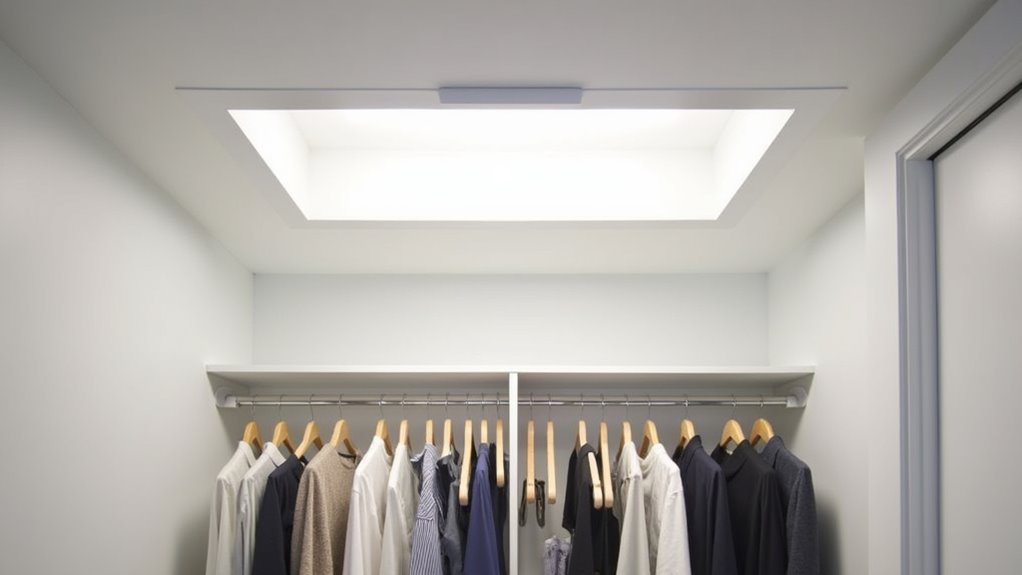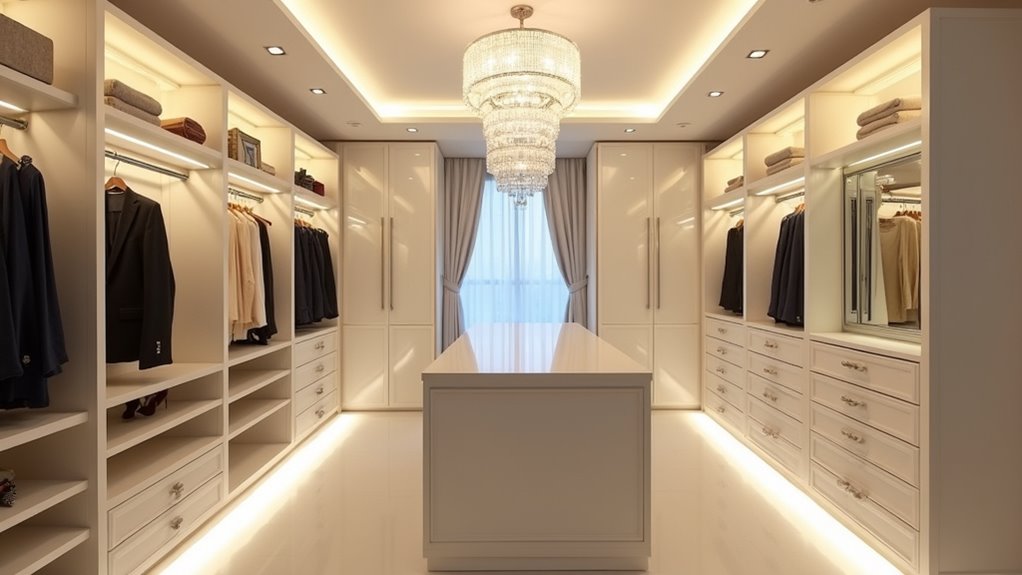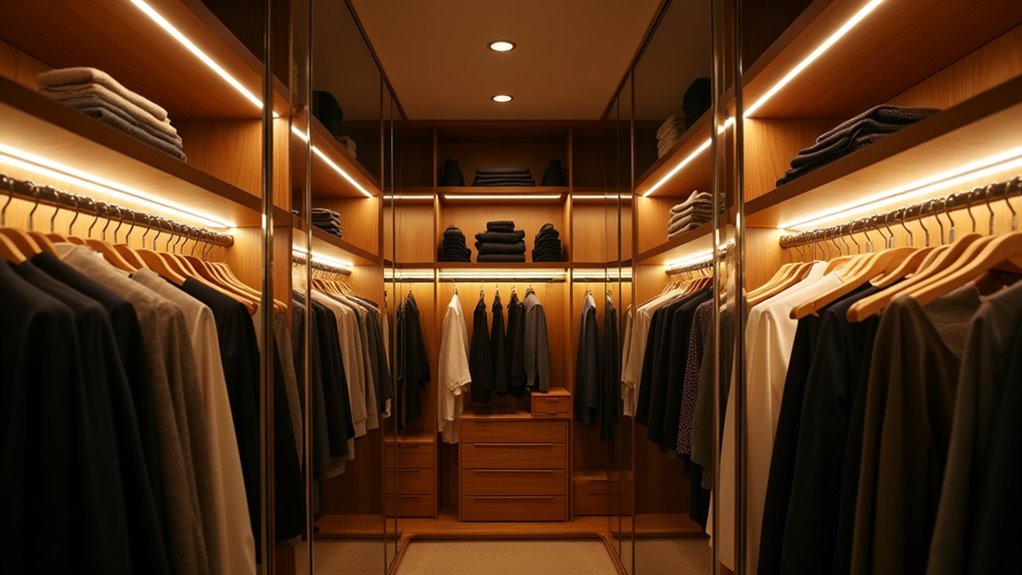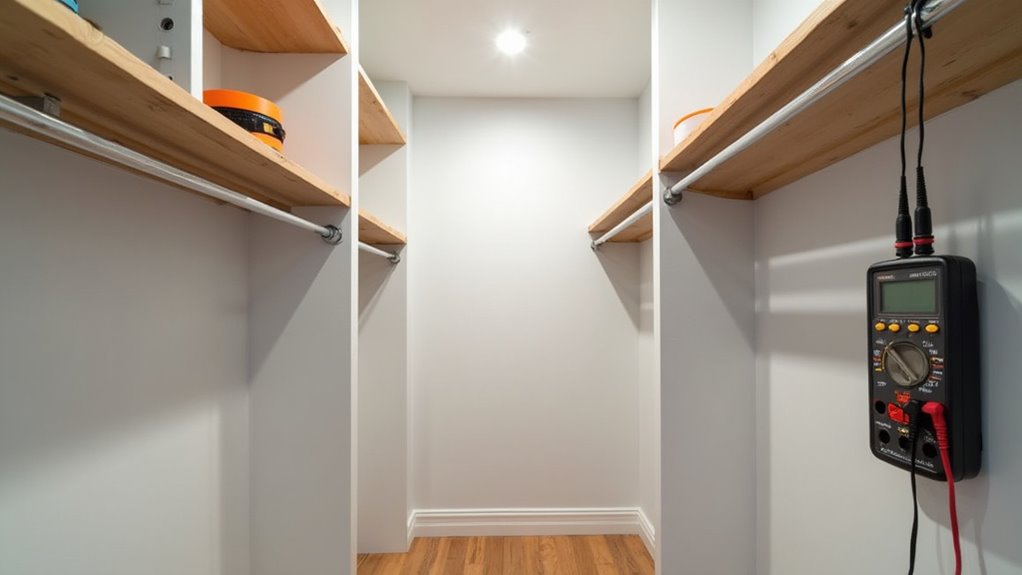Quality closet illumination requires deploying three distinct layers: ambient lighting for baseline brightness, task lighting targeting shelves and hanging rods, and accent lighting highlighting architectural features. You’ll need LED fixtures with 3000-4000K color temperature and CRI ratings above 90 to guarantee accurate fabric color rendering. Position vertical LED strips along sidewalls and beneath shelves to eliminate shadow zones, while motion sensors provide hands-free activation. Strategic fixture placement with dimming capabilities lets you customize brightness levels across functional zones, and the thorough approach below reveals how each component works together.
Understanding the Three Essential Layers of Closet Lighting
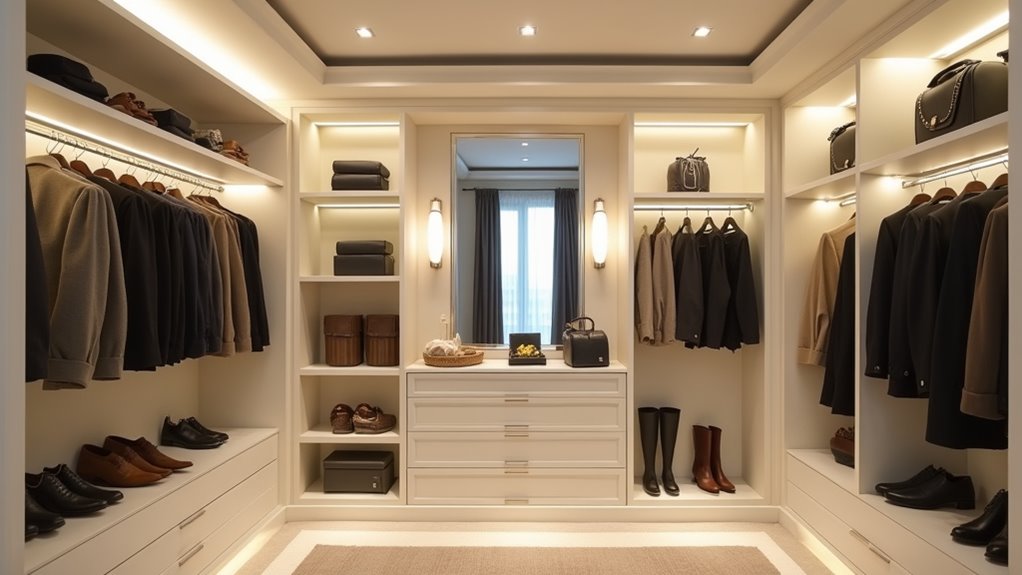
When designing effective closet illumination, you must structure your approach around three distinct yet complementary layers: ambient, task, and accent lighting. Ambient lighting establishes uniform brightness throughout your closet space, typically delivering 10–20 foot-candles through ceiling-mounted or recessed fixtures. Task lighting provides focused illumination, 20–50 foot-candles, on specific zones like shelves, drawers, and hanging rods where you need accurate color distinction. Accent lighting adds depth and dimension while highlighting architectural features and curated displays, functioning analogously to visual merchandising strategies in retail environments. This tri-layered methodology secures closet space optimization by eliminating shadows and dead zones. Integration requires smart controls and dimmers that allow independent adjustment of each layer, while motion sensors boost energy efficiency. High-CRI LEDs at 2700K deliver excellent color accuracy and warmth without heat emission. Installing recessed lights in a grid pattern across the ceiling ensures even distribution of ambient illumination in walk-in closets. Track lighting systems offer exceptional versatility by allowing you to direct individual lights in any direction to illuminate specific focal points throughout your closet. For enhanced security and control, consider WordPress-compatible smart lighting systems that can be managed through centralized platforms similar to how Wordfence manages site access.
Strategic Placement Methods for Maximum Coverage
You’ll achieve ideal closet illumination by implementing a layered lighting zone approach that combines ambient, task, and accent fixtures across ceiling, vertical, and shelf-mounted positions. Strategic fixture placement eliminates shadow zones by positioning light sources at multiple angles, particularly along wardrobe sides and beneath shelving, ensuring uniform coverage throughout the depth and height of your storage space. Adapting your lighting configuration to your specific closet layout, whether reach-in or walk-in, requires careful consideration of fixture spacing, beam angles, and mounting locations to enhance both functional visibility and aesthetic presentation. Surface-mounted fixtures mounted directly on walls or ceilings provide flexibility in placement for optimal illumination while maximizing space utilization in closets where recessed installation may not be feasible. Motion-activated lights enhance convenience in tight spaces by providing hands-free illumination when you enter the closet. Installing dimmer switches allows you to adjust brightness levels according to time of day and specific tasks, creating customizable lighting conditions that balance visibility with energy conservation.
Layered Lighting Zone Approach
As closet dimensions and storage configurations vary dramatically, implementing a layered lighting zone approach guarantees thorough illumination across every functional area. You’ll establish three distinct layers: ambient recessed fixtures provide baseline illumination, task lighting targets shelving units and hanging rods, while accent fixtures supplement decorative elements like display cases or architectural features. Install LED strips vertically along sidewalls to eliminate shadow zones, positioning additional strips beneath each shelf plane for direct task visibility. Configure 4000K LED technology with dimming capabilities across all zones, enabling you to optimize storage configurations through adaptive brightness control. Integrate motion sensors within each functional zone, shelving, hanging, and floor areas, ensuring automated activation when you’re accessing specific sections. Position adjustable track lighting toward shoe displays and accessory sections to highlight texture and maintain organized presentation. Consider battery-powered LED puck lights for flexible shelf illumination when hardwired installation proves impractical or cost-prohibitative. Install toe-kick lighting along the base to guide navigation during nighttime access and create a visually lighter appearance for the closet system. This systematic approach creates uniform light distribution while maintaining energy efficiency throughout your storage environment.
Eliminating Shadows With Fixtures
Shadow elimination begins with understanding the geometric relationship between fixture output, obstruction patterns, and reflective surfaces within your closet’s three-dimensional volume. Achieving uniform light distribution requires strategic positioning that accounts for physical barriers and beam intersection points.
Core placement protocols for avoiding obstructed illumination:
- Vertical bilateral mounting: Install fixtures on opposing sidewalls to create intersecting light cones that neutralize center-zone shadows while maintaining balanced lumen coverage across hanging rods and shelving units.
- Overhead staggered arrays: Deploy multiple ceiling-mounted sources in alternating patterns, ensuring overlapping beam fields that compensate for obstruction-induced dark pockets beneath storage elements. Recessed lighting installations provide a sleek appearance while delivering targeted illumination from ceiling positions that minimize visual clutter and maximize vertical clearance.
- Perimeter supplementation: Integrate LED strip lighting along shelf edges and vertical supports to provide continuous linear output, filling voids where primary fixtures cannot penetrate due to dimensional constraints or structural interference. Motion sensor lights eliminate the need for manual switching while conserving energy through automatic activation based on occupancy detection.
Adapting to Closet Layout
When closet dimensions exceed eight linear feet or incorporate multiple storage zones, single-point illumination creates predictable coverage gaps that compromise visibility across hanging areas, shelving depths, and corner recesses. You’ll need a balanced illumination approach that distributes fixtures according to spatial geometry, recessed LEDs in walk-ins follow grid patterns for uniform ambient coverage, while reach-in configurations position flush-mounts just inside openings, directed at rear walls. Track lighting along centerlines accommodates evolving layouts through adjustable heads. Corner and L-shaped spaces demand vertical strips in corners to penetrate depth zones effectively. Purposeful layering techniques combine overhead ambient sources with under-shelf horizontal strips and vertical frame-mounted LEDs, eliminating shadows from protruding rods or shelving hardware. Map obstacles during installation, ensuring fixture placement aligns with traffic patterns and functional zones requiring 20-50 foot-candles for detailed garment selection.
Selecting the Right Color Temperature for Your Wardrobe
Color temperature, measured in Kelvin (K), fundamentally determines how your lighting renders fabric hues and influences your wardrobe’s visual accuracy. You’ll need to balance warm tones (2700K-3000K) that create inviting ambiance against cool tones (4000K-5000K) that deliver superior color differentiation for precise outfit coordination. For optimal closet illumination, targeting 3000-4000K provides clean white light that maintains color accuracy without the harsh appearance of higher temperatures or the yellowish cast of warmer settings. This lighting range creates flattering, stylish lighting ideal for walk-in wardrobes where you assess your appearance and coordinate outfits. Beyond CCT selection, your fixture’s Color Rendering Index (CRI) directly impacts whether garments appear true-to-color or suffer from chromatic distortion under artificial illumination. Bulbs with CRI above 90 ensure excellent color vibrancy when evaluating clothing combinations and textile details.
Warm vs. Cool Tones
Selecting the proper color temperature for your closet lighting directly influences how accurately you perceive garment colors and textures during outfit assembly. Warm tones (2700K–3000K) produce amber-cast ambient illumination levels that soften whites and cool fabrics, while cool tones (4000K–6500K) reveal true garment shades through balanced hue blending. Understanding this spectrum guarantees ideal visibility:
- Task-specific installations: Deploy cool white (4000K–5000K) for precision matching and accessory coordination in active dressing zones.
- Material compatibility: Cool lighting mutes wood finishes’ natural warmth, whereas warm tones complement traditional millwork.
- Adjustable systems: LED fixtures with selectable CCT provide versatility, allowing changes between energizing and relaxing atmospheres.
Neutral white (3500K–4500K) bridges both extremes, delivering accurate color rendering across mixed-material closets without visual distortion. Strategically positioning your fixtures eliminates shadows and avoids dark spots that obscure garment details in recessed storage areas.
CRI for Color Accuracy
Accuracy in fabric identification hinges on your light source’s Color Rendering Index (CRI), a quantitative metric measuring how faithfully illumination reveals object colors compared to natural sunlight’s benchmark score of 100. You’ll need CRI 90+ for wardrobe applications where accurate color perception proves critical; lower values (below 80) yield dull, misrepresentative hues that compromise outfit coordination.
Specify manufacturer-rated CRI of at least 90; premium LEDs now offer CRI 95–98, approaching daylight fidelity. Verify ratings on packaging or technical datasheets before procurement. High CRI lighting enhances texture visibility and minimizes shadows through superior spectral distribution.
While CRI addresses color accuracy exclusively, you must layer this specification with appropriate color temperature selection and consistent brightness levels to achieve ideal wardrobe illumination. TM-30-15 metrics provide advanced analysis but remain secondary in consumer applications.
LED Technology Advantages for Modern Closet Spaces
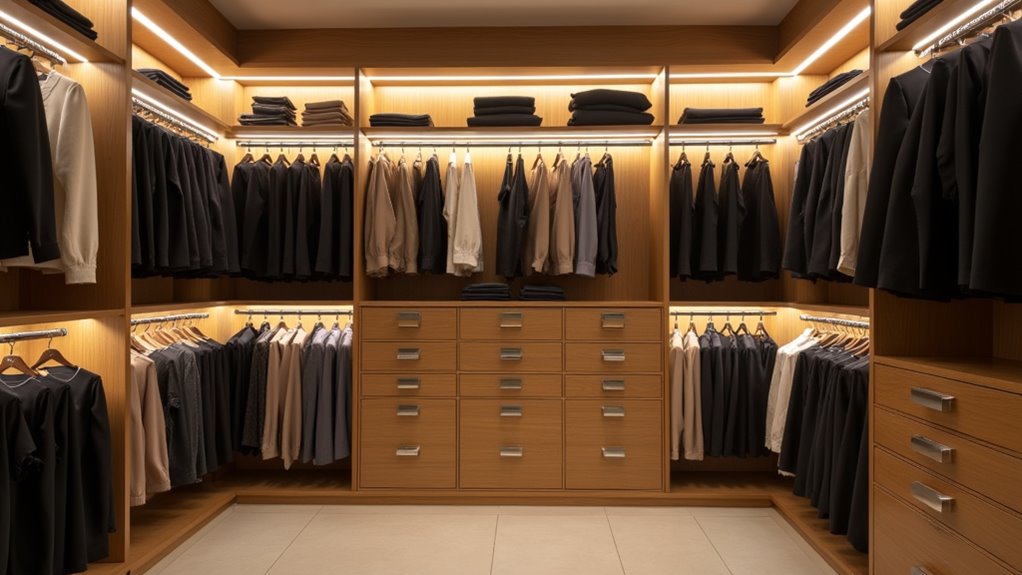
When evaluating illumination systems for contemporary closet installations, LED technology emerges as the definitive solution through measurable performance metrics and architectural integration capabilities. You’ll achieve superior heat dissipation performance in enclosed environments, eliminating fire hazards while maintaining favorable thermal management. The dimming capabilities enable precise lumen output control across multiple usage scenarios.
Critical LED Performance Advantages:
- Energy Efficiency Metrics – You’ll reduce consumption by 75-80% compared to incandescent systems, directly impacting operational costs and carbon footprint calculations.
- Longevity Parameters – Expect 25,000-50,000 hour lifespans with consistent luminous flux maintenance, minimizing replacement cycles and material waste.
- Color Rendering Index (CRI) – High CRI values ensure accurate color representation of textiles and accessories, essential for wardrobe coordination and material assessment.
Eliminating Shadows and Dark Corners Effectively
You’ll need to map your closet’s shadow zones before implementing solutions, identify where light fails to reach behind hanging clothes, beneath shelves, and in rear corners. Effective shadow elimination requires layering ambient, task, and accent fixtures rather than relying on a single overhead source. Install adjustable track lights or repositionable spotlights to target specific dark pockets as your storage configuration changes.
Identify Problem Areas First
Before installing any fixture, conduct a systematic assessment of your closet’s light distribution by mapping shadow zones during peak usage hours. Evaluate surface reflection by measuring how existing ceiling fixtures bounce off shelving and wall finishes. Document obstruction patterns created by hanging rods, deep shelving, and cabinet projections that block downward light flow.
Focus your analysis on three critical zones:
- Upper corner intersections where ceiling meets perpendicular walls, typically receiving minimal lumens from central sources
- Mid-level shadow bands behind hanging garments and between vertical dividers
- Floor-level recesses beneath lowest shelves and shoe storage units
Incorporate multi-mode lighting strategies by planning fixture types matched to each identified deficiency. Use photographic documentation to track illumination gaps across different times, ensuring thorough coverage before specification.
Layer Multiple Light Sources
Once you’ve mapped shadow zones and obstruction patterns, implement a layered lighting architecture that combines ambient, task, and accent sources to guarantee residual darkness is eliminated. Position overhead fixtures in grid patterns to establish shadow-free base illumination, then integrate LED strips beneath shelves and beside rods for focal zone illumination. Install vertical fixtures along mirror panels and puck lights targeting deep drawers to address obstruction-generated voids. Cross-illumination, placing sources on opposing planes, prevents shadow casting from shelving structures and hanging garments. Track lighting with adjustable heads allows you to redirect beams as storage configurations evolve. Maintain CRI 90+ across all layers to preserve color accuracy. Balancing ambient light with targeted task fixtures creates uniform coverage, while motion-activated controls certify immediate, hands-free operation throughout all closet zones.
Use Adjustable Lighting Solutions
Adjustable lighting solutions deliver dynamic control over photometric distribution patterns, enabling you to reconfigure illumination geometry as storage layouts and visual requirements evolve. Wireless control systems and adjustable mounting brackets provide unprecedented flexibility in targeting shadowed zones without permanent infrastructure modifications.
Strategic deployment includes:
- Track-mounted fixtures with articulating heads: Redirect beam angles to eliminate corner shadows as hanging configurations change
- Under-shelf LED strips with dimmer integration: Modulate lumen output for task-specific intensity requirements
- Swivel-mounted spotlights on ceiling rails: Concentrate luminous flux on accessory drawers and vertical storage segments
These solutions optimize visibility through precise beam control rather than increased wattage. Adjustable mounting hardware accommodates evolving spatial demands, while sensor-activated technologies reduce energy consumption during non-occupancy periods. The result is shadow-free illumination adaptable to functional needs.
Smart Automation Features That Enhance Convenience
| Automation Layer | Primary Function |
|---|---|
| Sensor Detection | Occupancy-based activation |
| Scheduling Protocol | Time-based shutoff sequences |
| Remote Access | Cloud-enabled app control |
| Voice Integration | Hands-free command execution |
| Protocol Communication | Zigbee/Z-Wave/Wi-Fi connectivity |
Programmable timers establish auto-shutoff intervals, while compatibility with smart ecosystems guarantees seamless multi-device coordination. Battery-powered sensors eliminate rewiring requirements, supporting universal deployment across diverse closet configurations.
Achieving High Color Accuracy With Proper CRI Values

While smart automation delivers convenience, color accuracy fundamentally determines whether your closet lighting serves its practical purpose. Achieving superior performance requires CRI values of 90+ to guarantee color fidelity when distinguishing garments.
Superior closet lighting demands 90+ CRI values, without accurate color rendering, you cannot reliably distinguish between similar garment shades.
Implement these layering strategies for ideal color rendering:
- Specify 90-95 CRI LED sources for primary illumination; this threshold enables accurate differentiation between similar fabric shades and prevents fashion coordination errors.
- Verify manufacturer specifications on packaging and technical sheets, as CRI disclosure assures you’re selecting products that meet professional-grade standards rather than settling for inadequate 70-80 ranges.
- Pair high CRI with appropriate color temperature (3000K warm to 5000K daylight) and sufficient lumens, and color fidelity becomes perceivable only when spectral uniformity and brightness levels support the application’s task-oriented demands throughout shelving and hanging zones.
Energy-Efficient Solutions That Lower Your Power Bills
| Solution Type | Energy Impact | Implementation Method |
|---|---|---|
| Motion Sensors | Auto-shutoff efficiency | Door-integrated activation |
| Smart Dimmers | Variable output control | App-based scheduling |
| Strategic Placement | Reduced fixture count | Optimized lighting layouts |
Under-shelf LED strips and rod-mounted linear fixtures create targeted illumination zones without over-lighting, while reflective interior surfaces amplify existing output. Battery-operated units eliminate wiring losses, and Energy Star certification guarantees verified performance metrics. Directional fixtures concentrate lumens precisely where needed, preventing wasteful spillover into unused zones.
Safety Standards and Clearance Requirements for Fire Prevention
Closet lighting installations demand strict adherence to National Fire Protection Association (NFPA) 70 and National Electrical Code (NEC) clearance specifications that prevent ignition hazards in confined storage spaces. You’ll need code-compliant clearances measured from fixture surfaces to combustible materials, minimum 6 inches for incandescent units, 6-12 inches for fluorescent assemblies, and 12 inches for non-IC-rated LED configurations.
Critical safety requirements include:
- Surface-mounted fixtures with UL-rated enclosures preventing direct contact with stored textiles, paper, or plastics
- Recessed installations featuring IC-rated housings and thermal barriers isolating heat transfer pathways
- Sensor-activated switching eliminating manual wall switches, reducing ignition points while maintaining 18-inch clearance below sprinkler heads
You must position junction boxes and concealed wiring per NEC Article 410, ensuring fire-rated construction in enclosures exceeding 50 square feet containing combustibles.
Customizable Lighting Systems for Changing Storage Needs
As your storage requirements evolve through seasonal wardrobe rotations, organizational system upgrades, or lifestyle changes, modular lighting architectures deliver reconfigurable illumination without costly electrical retrofits. LED strip lights with adhesive backing and track systems featuring adjustable heads provide flexible positioning options that adapt as shelving configurations shift. Plug-and-play connectors enable customizable wiring configuration through simple expansion or reduction of components without hardwiring modifications. Integrated power supply rails accommodate fixture supplements while removable sensor units optimize activation points regardless of organizational changes. Clip-on, magnetic, and stick-on fixtures allow tool-free repositioning across varying surfaces. Dimmable controls with zone programming divide closets into independently managed lighting sections, while color temperature adjustment suits changing wardrobe compositions. Battery-powered modules eliminate outlet dependencies, and expandable modular kits facilitate capacity increases as storage volume grows.
Frequently Asked Questions
What Is the Average Cost to Install a Complete Closet Lighting System?
You’ll typically invest $400 on average for a complete closet lighting system, though lighting cost considerations span $100–$650 for standard installations. Your closet lighting budgeting should account for fixture type; recessed runs $125–$300 per unit, while LED strips cost $200–$500 per system. Factor in electrician labor at $90–$200 hourly for 2–4 hours. Complex wiring, multiple fixture layers, and custom configurations can push high-end installations in the direction of $6,500 for extensive illumination solutions.
Can I Install Closet Lighting Myself or Do I Need an Electrician?
You can handle DIY lighting installation for basic battery-operated or plug-in systems using standard tools and 14-gauge wiring. However, professional installation recommendations apply when you’re dealing with hardwired circuits, complex junction box integrations, or code-compliance requirements. If you’re tapping into existing electrical infrastructure or installing transformer-based low-voltage systems, you’ll need an electrician’s expertise. Always assess your technical comfort level; simple surface-mounted LED strips work for DIY, while integrated lighting circuits demand licensed professionals.
How Do I Retrofit Lighting Into an Existing Closet Without Major Renovations?
You’ll achieve retrofit success by layering battery-operated LED strips along shelving edges and integrating smart sensor modules at entry points, no wiring required. Mount magnetic puck lights inside hidden compartment integration zones for discrete access illumination. Use adhesive-backed fixtures with programmable occupancy detection for hands-free activation. This approach eliminates drywall penetration while maintaining code compliance. Position wireless controllers strategically to optimize lumen distribution across vertical and horizontal planes, ensuring uniform foot-candle levels throughout your existing closet infrastructure without invasive electrical modifications.
What Lighting Works Best for Jewelry Display or Tie Storage Areas?
You’ll need focused task lighting with high-CRI LEDs (≥90) for jewelry and tie storage. Install LED strip lights or compact puck lights inside drawers, ensuring uniform placement to eliminate shadows. Opt for warm temperatures (2700K–3000K) for gold pieces or cool white (4000K) for diamonds. Customizable illumination levels through dimmers let you adjust intensity per item type. Motion-activated sensors augment convenience while low-heat, UV-free specifications protect delicate materials from degradation, critical for preserving textile and gemstone integrity.
How Often Should LED Closet Lights Be Replaced or Maintained?
You’ll replace LED closet lights every 25,000–50,000 hours, roughly 40+ years with minimal use, though LED lifespan expectations vary by quality. Maintain quarterly by cleaning fixtures to prevent dust accumulation that degrades thermal management layers. Inspect sensor arrays and driver components semi-annually for ideal performance. You’re addressing dimming below L70 thresholds or flickering as replacement triggers, not adhering to rigid schedules. Routine maintenance schedules should prioritize connection integrity checks and lens cleaning over premature lamp replacement in properly ventilated installations.

